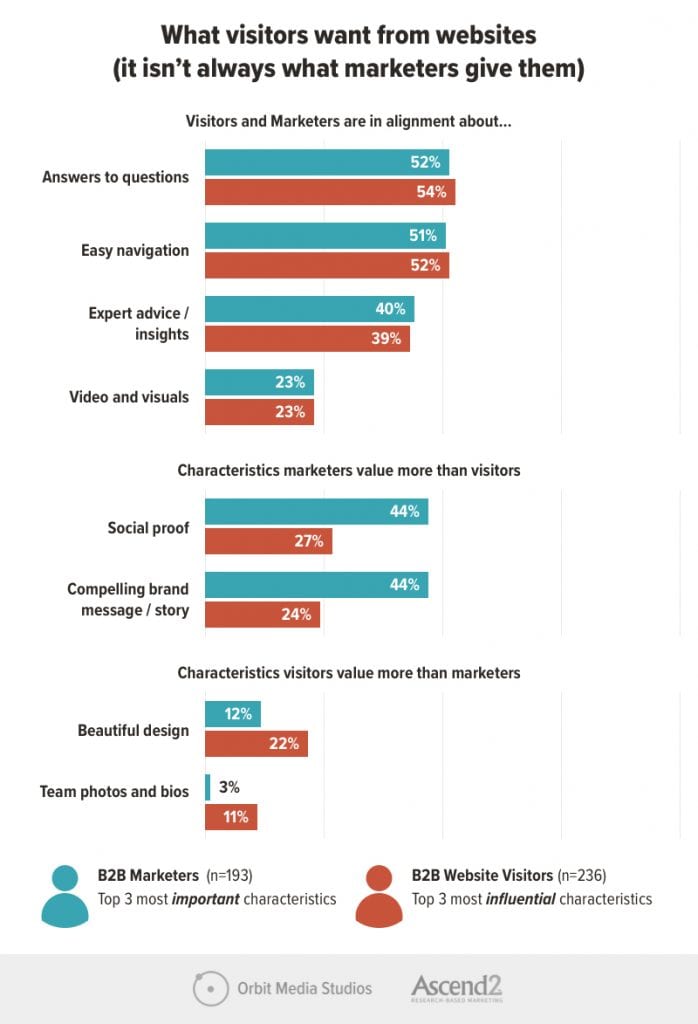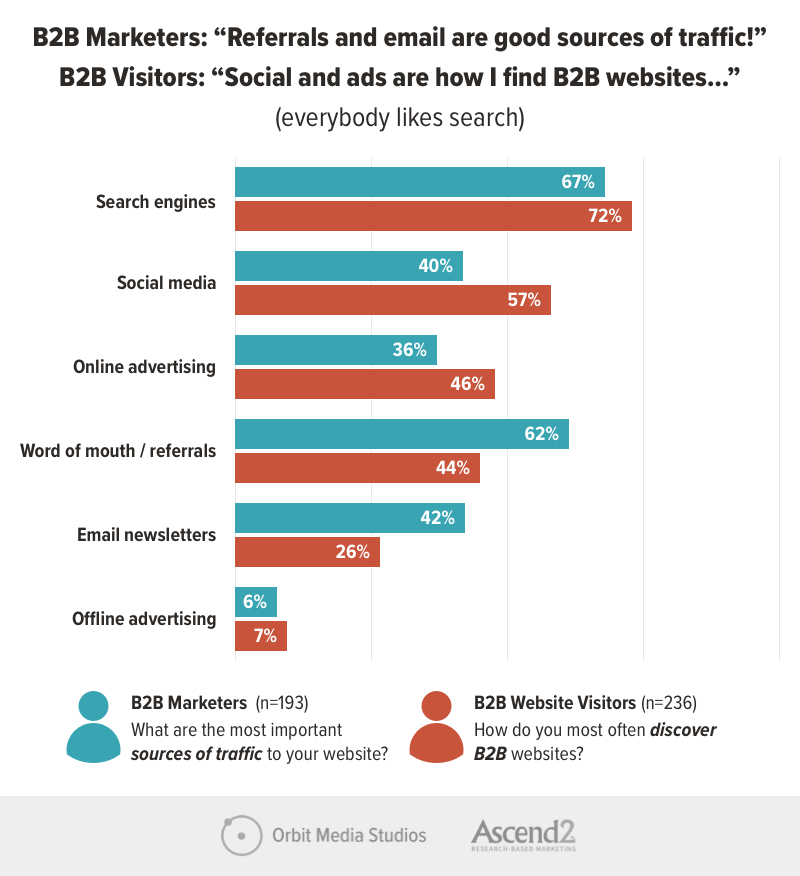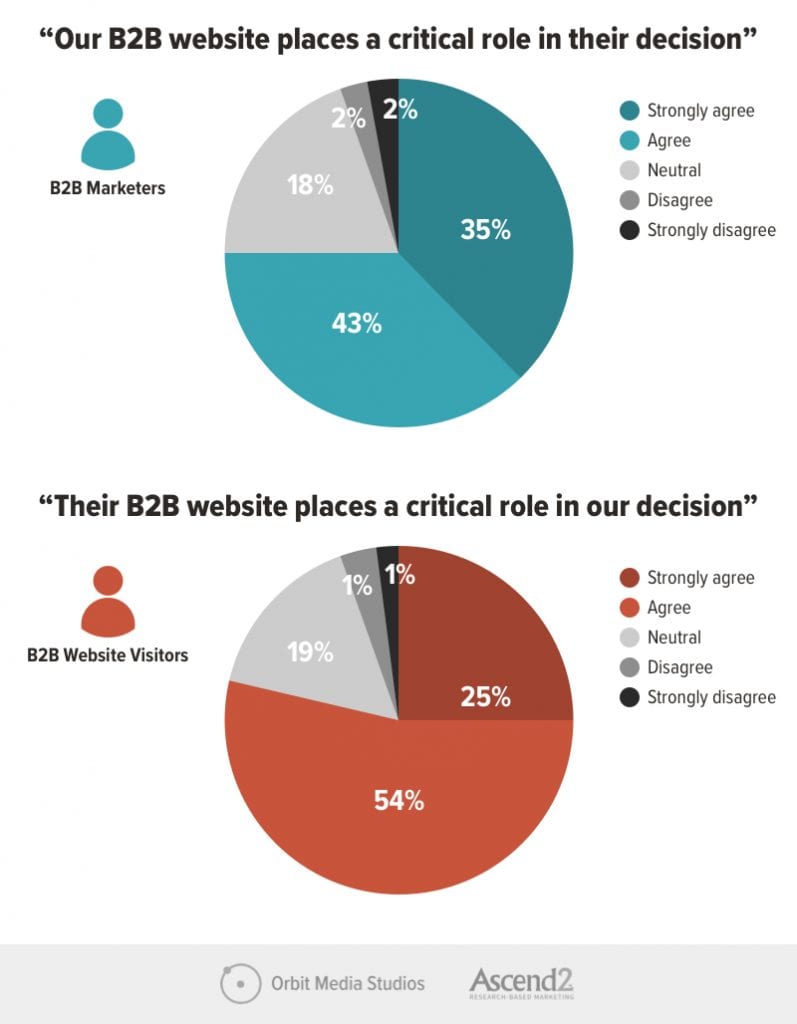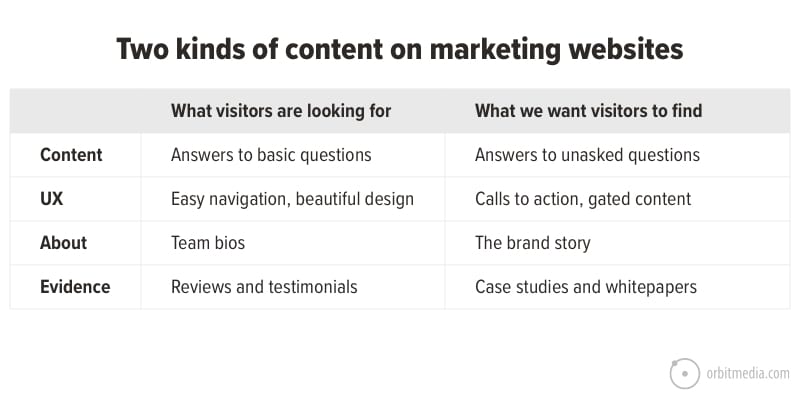We have planned and designed hundreds of websites. Every day, we live in the world of website features, content and designs. That’s because we’re a web design company! But most digital marketers have been through the process at least once by now.
As brands, we know what we want our websites to say and do.
As visitors, we know that websites often fail to give us what we’re looking for.
Why the gap? Because these are often two different things: what brands want to show on their website and what visitors want to find on that website.
With the hopes to discover the specific gaps, we designed a dual survey that asked B2B buyers (website visitors) and B2B brands (website contributors) what they think is important.
Together with research firm Ascend2, we got 200+ responses from each group. Today we are sharing our findings and analysis.
What do website visitors want …and what do marketers give them?
The first question was the most general. Here is how it was posed to the two audiences:
- B2B website visitors: Which of the following CHARACTERISTICS of a marketing website have the most influence on your purchase decisions?
- B2B website contributors: Which of the following CHARACTERISTICS contribute most to the success of your marketing website?
They could choose up to three options from a list of high-level website attributes. The data shows some alignment, but also big differences:

Visitors to B2B websites are there for a reason. We often say “there’s a true story in the life of every visitor to every webpage.” They have questions and they’re looking for quick answers.
The data show that visitors value quick access (easy navigation, visuals) to relevant, high quality information (answers, advice, insights).
The majority of both visitors and marketers responded that easy access to relevant answers is the key characteristic of a website.
Far fewer visitors listed beautiful design or team bios as the top three characteristics. These are less likely to be a top concern for visitors. But visitors were twice as likely as the marketers to choose beauty.
Of course, design still matters.
Now, look at the marketer’s perspective. Marketers were far more likely to list brand story and social proof as one of their top three options. Of course, these are important to marketers because they can improve conversion rates.
…but our visitors aren’t worried about our conversion rates.
What are the top B2B website features, according to both visitors and marketers?
For the next question, we get into the specifics. Here are the questions posed to both groups:
- B2B website visitors: Which of these website FEATURES do you find most useful?
- B2B website contributors: Which of these website FEATURES contribute most to the success of your website?
They could choose up to three options from a list of common website features. The data shows far less alignment than the previous section. You can almost feel the tension between the website and its visitor.

Visitors want features that help them get to information quickly: search boxes, chat and social media buttons. I agree that it’s important to give visitors easy access to answers, but I don’t necessarily recommend the use of these specific features on B2B websites.
In fact, I don’t generally recommend any of the features that visitors say they like in this report.
Search boxes aren’t always useful, according to Analytics. Live chat requires human resources, which aren’t always available. Chatbots require software, which isn’t free. It’s worth it only if conversion rates rise. And the research shows that slideshows are not generally effective.
Conversion expert Peep Laja also warns us about taking these findings as a prescription for B2B website features.
 |
Peep Laja, Wynter“What people say they want and what they actually want might not overlap. Anyone in sales or product management knows this – asking people about their future behavior means little about what they’ll actually do. For instance – people say they want sliders. Overwhelming evidence shows that it harms conversions, e.g. it actually gets in the way and distracts people. They might just not be aware of it.“ |
Marketers like the features that tie directly to conversions. The features that collect visitor data (CTAs, content gates and popups) are the features that marketers find the most important. No surprise.
How do visitors (and marketers) feel about gated content?
Let’s look at a specific feature that gets a lot of attention. Gated content (aka the “lead magnet,” “content upgrade” or “ethical bribe”) is content that requires the visitor to enter their email address to access.
This feature is the cornerstone of marketing automation.
It’s a common tactic and a lot of marketers have strong feelings about it. But how do visitors feel about gated content? We asked our respondents if they agree to these statements:
- B2B website visitors: “I’m willing to provide my contact information in exchange for relevant content”
- B2B website contributors: “Collecting visitors’ information through gated content is important to our success.”
Here’s how the responses line up:

Looks like visitors are fine with the transaction, trading their contact info for relevant content. Two thirds of respondents agreed (or strongly agreed) with the statement.
It’s the marketers that seem to have more misgivings. 21% disagreed that gates are important to success.
 |
Jessica Best, Barkley“This is a case of marketers beating themselves up over a best practice without asking users. The data shows that highly debated tools like gates or pop over modals… work! As long as there’s something juicy in it for the user, both of those “hated” tools work to garner opt ins. Better to test it with your own website/users than to die on a “UX best practice” that users don’t actually care about.“ |
What content formats are most useful to visitors? And most important to marketers?
Next, we look past the UX and into the formats of the website content.
- B2B website visitors: Which of the following CONTENT FORMATS do you find to be most useful in your decision-making process?
- B2B website contributors: Which of the following CONTENT FORMATS do you find to be most effective at achieving the objectives of your website?
Both groups could choose up to three options from a given list. The data reveals the different preferences between the consumers and the creators of the website content.

“Visitors come for answers, and while they’re here, we’ll give them social proof.” I’ve said that hundreds of times. So it surprised me to see that, given these options, reviews/testimonials were the top choice for B2B visitors. It shows the high value we all place on third-party endorsements.
- Visitors’ preference for original research reflects the desire for high quality content.
- Visitors’ preference for infographics and video reflects the desire for easy to consume content.
Marketers want to show proof with a story behind it, preferring case studies to reviews/testimonials. But the research suggests we should prioritize testimonials over case studies. Bonus points for video testimonials. They combine two of the top format preferences of visitors.
Visitors find original research to be more valuable than how-to content. If you haven’t yet, consider getting some original research into the content mix.
How do visitors like to find B2B websites? How do marketers like to be found?
It’s a question of channel preference. We asked this top-of-the-funnel question to both groups.
- B2B website visitors: How do you most often discover B2B websites?
- B2B website contributors: What are the most important sources of traffic to your website?
Respondents chose from a list of traffic sources, online and offline. The data shows both alignment and differences.

Search engines are the top pick for both B2B visitors and marketers. Makes sense. It’s a fast way to find any B2B service you can imagine. And search is intent-driven.
- Visitors know they’ll find something at least somewhat relevant.
- Marketers know that these visitors are at least somewhat qualified.
 |
Hailey Friedman, GrowthBar“For B2B, it makes sense that search engines are the most popular method of discovery. There are countless keywords both short and long-tail, allowing you to create diverse, targeted content that’s both useful and high-converting.” |
Past that, the answers diverge.
B2B marketers like word of mouth and referrals. These visitors have even stronger intent. They’re problem-aware, solution-aware and brand-aware. These visitors often convert quickly, sometimes going straight to the contact form.
Visitors seem to prefer social media. To me, this is a surprise. I’d expect to see this in B2C, but in B2B? Maybe they’re finding potential partners on LinkedIn. That’s a social network B2B brands can’t afford to ignore.
Visitors report that paid ads are among the best ways to find websites. Marketers don’t love paid channels quite as much.
Conversely, marketers do consider email newsletters to be important sources of traffic, while visitors tend not to report email as a way to discover a B2B website.
How important are B2B websites?
Finally, we asked about the general importance of websites in the buyer’s decision making process.
- B2B website visitors: “Their B2B website plays a critical role in our decision process.”
- B2B Website Contributors: “Our B2B website plays a critical role in their decision process.”
On this, the two groups are perfectly aligned. Roughly 80% of both groups agreed that the website is critical in the B2B decision making process.

Do we need to give visitors what they want?
Yes, but not always.
When we don’t meet the visitors’ basic expectations, they’re likely to leave. 100% of our visitors know that there are hundreds of other websites (millions, really) that can give them what they’re looking for.
First, give them what they want…
The basic finding of the visitor survey is that they want access to information.
- Clear, descriptive headers
Let visitors know they’re in the right place - Simple navigation
So they can segment themselves into the content quickly - Answers to basic questions
The content on each page flows through the answers to their questions in a roughly prioritized order.
…then give them what we want them to have
While they’re here, we’ll inject into their field of vision the things that we want them to find.
Maybe they didn’t come to read case studies and testimonials, but you can bet that we’ll add them throughout the site (Ideally, not on a separate, easily avoided testimonials page)
So there are really two kinds of content on marketing websites:

Naturally, these often overlap. I could add the classic venn diagram here, but you’ve probably seen that one already.
This should be familiar to anyone who walks into a grocery store. You need milk, but you end up buying milk and BBQ chips. Why the chips? You had to walk past them to get to the milk.

If the store was designed just to meet the shoppers needs, all of the most popular items would be up front. You’d never see the BBQ chips and sales would be low.
Your website is a marketing tool. It’s not a charity information hub. Ultimately, it needs to serve the business and meet business goals.
There isn’t a perfect alignment between visitor desires and the website content / UX. There doesn’t need to be. The ideal outcome meets the needs of both the visitor and the marketer.
Milk and BBQ chips.
Win win.
Methodology:
Survey responses were gathered from 429 B2B professionals during April and March of 2021. 236 respondents self identified as B2B website visitors (“I visit and use websites when making B2B purchase decisions”) and 193 self identified as B2B website contributors (“I help manage the content and design of a B2B marketing website”). We refer to the second group as “B2B marketers” in this report. Respondents were recruited from three primary sources: the Orbit Media newsletter list, LinkedIn and a panel created by our research partners at Ascend2.
Acknowledgements:
Big thanks to Todd and Jenna at Ascend2. If you would like to work with Ascend2 on your own original research project, contact Todd. We are grateful to the 236 respondents who took the time to answer our questions. And finally, to the Orbiteers who helped make this happen. That’s Amanda Gant (editor), Jantzen Loza (graphics) and our reviewers Laurel Miltner, Brad Knutsen, Barrett Lombardo and Kurt Cruse.




